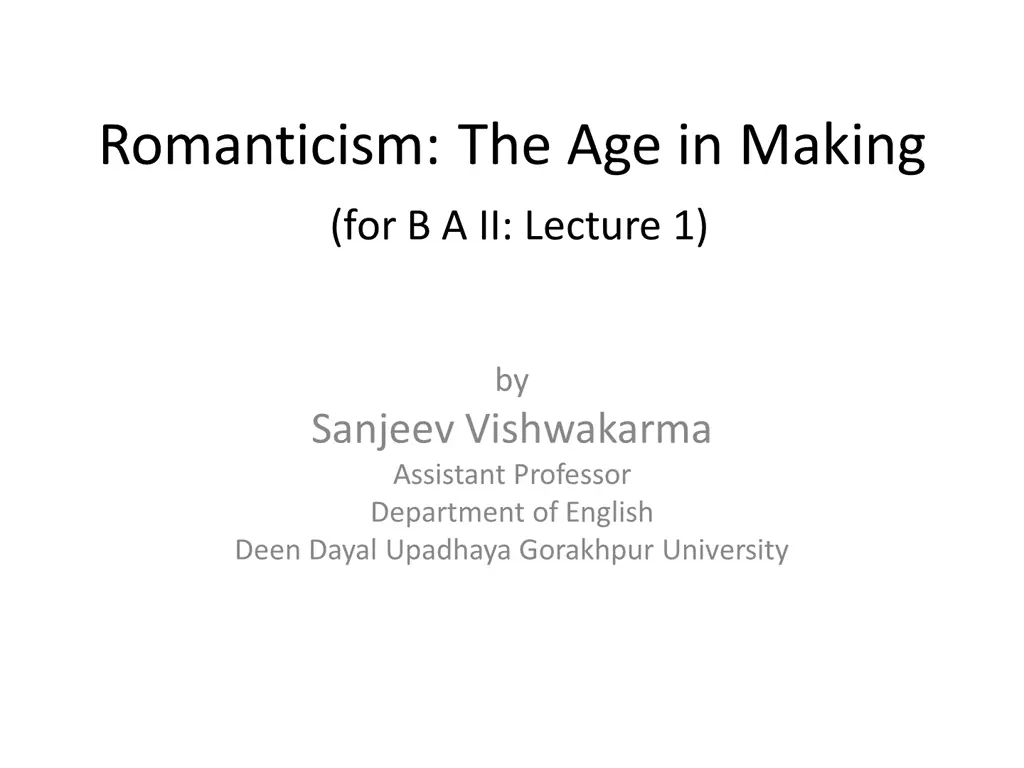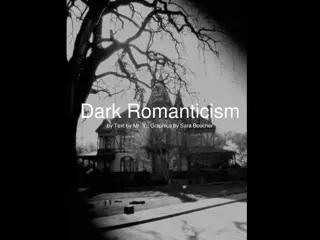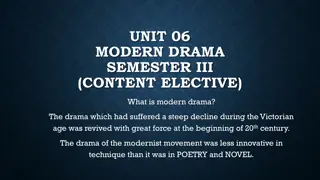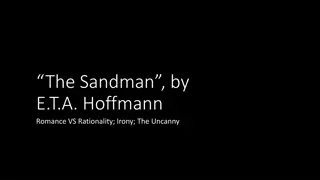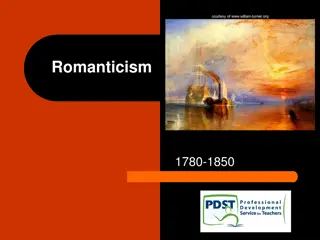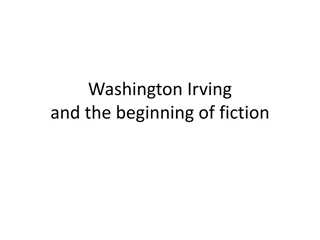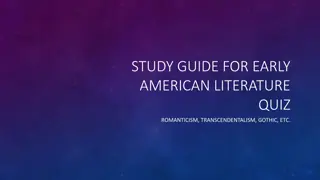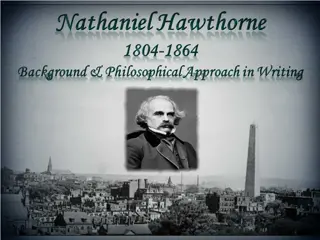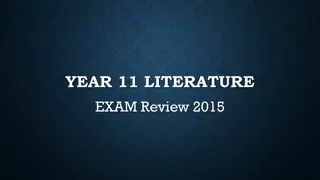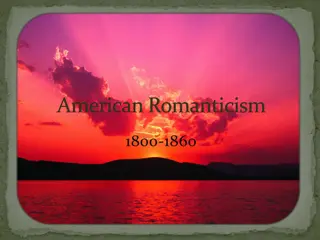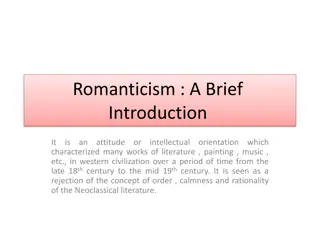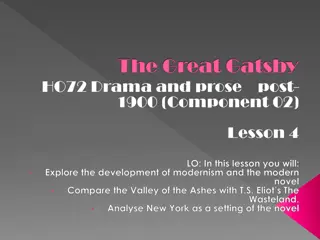Romanticism: The Age in Making
Explore the origins and characteristics of Romanticism in this informative lecture, covering the Enlightenment, American Independence, and the shift away from Enlightenment Neo-classicism.
Download Presentation

Please find below an Image/Link to download the presentation.
The content on the website is provided AS IS for your information and personal use only. It may not be sold, licensed, or shared on other websites without obtaining consent from the author.If you encounter any issues during the download, it is possible that the publisher has removed the file from their server.
You are allowed to download the files provided on this website for personal or commercial use, subject to the condition that they are used lawfully. All files are the property of their respective owners.
The content on the website is provided AS IS for your information and personal use only. It may not be sold, licensed, or shared on other websites without obtaining consent from the author.
E N D
Presentation Transcript
Romanticism: The Age in Making (for B A II: Lecture 1) by Sanjeev Vishwakarma Assistant Professor Department of English Deen Dayal Upadhaya Gorakhpur University
Acknowledgement This presentation has been prepared after consulting various books on the Romanticism. It extensively quotes from the book Understanding Romanticism in bullet-form and the explanation of the contents is the teacher s own (based on his readings about the age). The teacher doesn t claim any authority over the contents included in this presentation. This presentation is meant only for giving a basic understanding of the age by exploring some facts and concepts in the above mentioned books. It has not been produced for any commercial purposes.
What is Romanticism? The word "Romantic" derives from the Old French romanz, meaning the vernacular romance languages that developed from Latin - Italian, French, Spanish, Portuguese, Catalan and Proven al. The medieval romance or romaunt came to mean a tale of chivalry written in one of these romance languages, usually in verse, and often taking the form of a quest.
The Enlightenment To understand Romanticism, it is necessary first to understand the Enlightenment. As the "problem child" of this great movement, Romanticism shows many of the characteristics of its parent, but equally some radical differences. The Enlightenment affected most of the Western world during the late 17th and 18th centuries.
The Enlightenment It was above all a movement which sought to emancipate mankind, regardless of political frontiers, from the triple tyranny of despotism, bigotry and superstition. The weapons in this fight were: 1- The great advancement in learning marks this age. 2- The possibility of a concentrated intellectual movement 3- Rationalism as the common language of science, philosophy and literature.
The Enlightenment Momentous advances occurred in science, philosophy and politics. The discoveries of Sir Isaac Newton (1642-1727) confirmed the regular and ordered nature of the universe. The philosopher John Locke (1632-1704) asserted that only the information of the senses, experience and observation could provide true understanding of the external world. Scientific knowledge could banish superstition.
The Enlightenment Philosophers, satirists, scientists, artists, politicians and intellectuals attempted to banish man's dependence on received wisdom and the authority of the Church in favour of a theory of existence in which man could stand unaided at the centre of his own rational universe. Rationalism (the theory that reason is the foundation of certainty in knowledge). Materialism (the theory that nothing exists but matter, and that its movements govern consciousness and will).
The Enlightenment Empiricism (the theory that observation and experiment are the foundation for knowledge) Determinism (the theory that human action is not free, but determined by motives regarded as external forces acting on the will) Utilitarianism (the theory that the moral dimension of human actions is determined by their capacity to produce happiness). These were some of the philosophical approaches of the age. Man was potentially perfectible, and the universe potentially discoverable, through the action of the intellect.
The American Independence The northeastern area of America founded by dissident English Puritans was effectively an extension of England, and the climate of thought at the time of the Rebellion was inspired by the great English prototypes of Enlightenment empiricism philosophers Francis Bacon and John Locke, and scientist Isaac Newton. Empiricism, the science of observation, provided the moral and philosophical groundwork for the aspirations of the American colonists.
The American Independence The Declaration of Independence (1776) combines an empirical observation on mankind with a moral and political conclusion. We hold these Truths to be self-evident, that all Men are created equal, that they are endowed by their Creator with certain unalienable Rights, that among these are Life, Liberty, and the Pursuit of Happiness.
Enlightenment Neo-classicism The movement from which Romanticism distanced itself was not the Enlightenment itself, but the style of art in which the Enlightenment ethos was embodied Neo- classicism. This was the expression in artistic terms of the 18th century s search for the founding principles of humanity, stripping away the rotten layers of superstition to reveal universal morally-based truths.
Enlightenment Neo-classicism Neo-classicism flowered earlier in literature (from the late 17th to the early 18th centuries) than it did in art and architecture (late 18th to early 19th centuries). It was often believed that art, like the new society which rational inquiry will bring into being, must be founded on clear principles. Regularity of form and beauty of proportion, in the art of classical antiquity were guiding principlr of Neo-classicism.
The Gothic Revival Neo-classicism was opposed by another trend in 18th century northern Europe-- the revival of medieval Gothic architecture and a widespread popular taste for the Gothic in literature. Both movements were neatly encapsulated in England by Horace Walpole (1717 97), who not only built the first major monument to the revival in the form of his Gothic house, Strawberry Hill (1748), but also wrote the first great Gohic novel , The Castle of Otranto (1764).
The Gothic Revival Romantic nationalists tended to look back to medieval life as an archetype to be imitated. British Gothic imitated a pre-Reformation Catholic past. But such nostalgia was a contradiction in Britain, since Romanticism itself sprang from essentially Protestant principles of self-determination and individual faith.
Sublime Imaginings One unforeseen side-effect of the Enlightenment was to illuminate the unexplored recesses of the material world. Empirical scientific inquiry, which had assumed that the Divine Order of the cosmos was waiting to be discovered beneath natural systems, succeeded in demonstrating exactly how complex and impenetrable the physical world could be.
Sublime Imaginings The sense of the sublime (the exalted , the awe-inspiring ) was increasingly used to bridge the gap between the limited human faculties of understanding and the unimaginable infinity of the physical universe.
Classical Tour, Romantic Journey The poet Thomas Gray (1716-71) and the Gothic novelist Horace Walpole gave an early account of the sublime in their description of a trip across the Alps in 1739-41. They were actively seeking new extremes of sensation as an aesthetic experiment. It was said, Not a precipice, not a torrent, not a cliff but is pregnant with religion and poetry.
Rousseau and the Romanticism Nature and Society: Rousseau took the illusory state of nature as a model for a less oppressive and unequal form of civilization. He also thought that private property was the cornerstone of a corrupt modern society. Rousseau therefore differs radically from previous social contract theorists such as Hobbes and Locke.
Rousseau and the Romanticism Rousseau believed: 1- The state of nature is a savage and unsatisfactory form of existence. 2- It is the reason why we prefer to accept political authority in its various forms. 3- The reverse is true! We have exchanged our naturally free state for a condition of social slavery.
Suggested Readings Ferber, Michael. Romanticism: A Very Short Introduction. New York: OUP, 2010. Heath, Duncan and Judy Boreham. Understanding Romanticism. USA: Totem Books, 1999. Day Adian. Romanticism: The New Critical Idiom. New York: Routledge, 1996. James, R A Scott. The Making of English Literature. UK: Martin Secker and Warburg LTD, 1940.
